An interview with wildlife artist Pollyanna Pickering
Pollyanna Pickering is widely recognized as one of Europe’s foremost wildlife artists, and is one of the most published fine artists working in Britain today. She is an honorary patron of The Wildlife Art Society International, and a signature member of the Artists for Conservation Foundation and the Society of Feline Artists. She is also a full juried member of the New York based Society of Animal Artists. A familiar face on TV, the most recent documentary about her work Made in England was broadcast on BBC1 last year.
Pollyanna was born in Yorkshire an she began her real art training at Rotherham Art School, where, in her first year she won the award for most promising student – and met her future husband, Ken Pickering, an industrial designer. She went on to study for a further three years at the London Central School of Art, graduating with distinction.
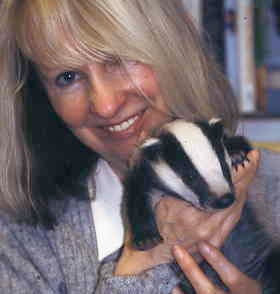 Pollyanna Pickering |
Pollyanna’s original work has been exhibited in top galleries internationally, including the Royal Academy. Her paintings hang in private and corporate collections world-wide from Siberia to Australia, and celebrity collectors of her work include John Hurt and David Bowie, while Sheik Mohammed has a specially commissioned series of paintings of his ascot winners. Her work has been presented to Princess Anne, and she has even been commissioned to paint Her Majesty the Queens’ favorite racing pigeon! Pollyanna’s work will be familiar to most people through her extensive range of published work. Her limited edition and fine art prints, books, ranges of greeting and Christmas cards and gift ware are sold throughout the UK and exported into over eighty countries world-wide. For fifteen years Pollyanna ran a registered hospital for birds of prey from her home. Caring mainly for injured and orphaned raptors, she also rehabilitated foxes, hedgehogs, squirrels and other mammals, all of which feature in her work. This close contact with the creatures in her care is reflected in the realism and vitality of her work. Pollyanna’s determination to paint only animals which she has observed in their natural habitats has lead her into a remarkable and unique series of journeys into some of the most inhospitable areas of the globe.
The following is an interview conducted by Shubhobroto Ghosh.
Shubhobroto Ghosh: Where were you born?
Pollyanna Pickering:
Leeds, England
Shubhobroto Ghosh: Did you always like animals?
Pollyanna Pickering:
Yes – I loved animals from being a small child. I spent a lot of time drawing, and loved to try and sketch the barn owls quartering the fields behind my home.
Shubhobroto Ghosh: Did your parents encourage your interest in animals?
Pollyanna Pickering:
Yes – my parents were also very fond of animals and wildlife.
Shubhobroto Ghosh: What did you study and where?
Pollyanna Pickering:
I always loved drawing and painting as a child, and when I announced that I would like to go to art school, my headmistress summoned me to her office with a portfolio of my best work. She looked through it in silence, slammed it shut, and said ‘You’ll never make a living at that!’ Luckily my parents had a little more faith in my abilities, and encouraged me to complete a foundation course at Rotherham Art College, and I then went on to study for a further three years at the London Central School of Art.
Although I didn’t paint a single bird or animal the entire time I was art college, I began to go in that direction shortly after I went freelance. I have always loved wildlife, and I believe that that showed through in my paintings.
Shubhobroto Ghosh: What made you take up painting as a profession?
Pollyanna Pickering:
I always intended to be a professional artist from the day I started art college. The one thing they don’t teach you is how to make a living – so after I left I spent a couple of years teaching art in high schools. I took the courage to leave teaching and go freelance 40 years ago.
Shubhobroto Ghosh: Which was your first painting exhibition?
Pollyanna Pickering:
I held an exhibition in Leeds, at the home of a well known opera singer, exhibiting a wide range of paintings including landscapes and abstracts as well as wildlife.
Shubhobroto Ghosh: When did you feel that you could become a full fledged professional painter?
Pollyanna Pickering:
Probably when the first exhibition sold out – and got good reviews in the press. It gave me the confidence to know that people liked my work enough to buy it.
Shubhobroto Ghosh: What animals have you painted in the wild and in which countries?
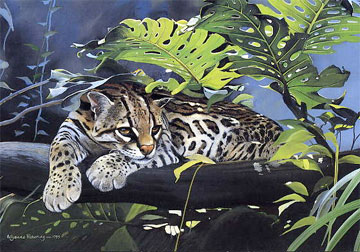 ‘The Heart of the Jungle’ painting by Pollyanna Pickering |
Pollyanna Pickering:
I have been very lucky, and traveled widely to study and paint wildlife. I have traveled to the High Arctic to paint polar bears, where I traveled by dog sled and camped on the ice in tents and igloos, several time into Africa (Kenya, Namibia, and South Africa) to paint big cats, and into Ethiopia to track Abyssinian wolves. I have also painted wolves in Transylvania and North America, and the native wildlife of Central America. I worked in temperatures of -60 to paint Amur Tigers in the Russian Far east! One of my most famous expeditions took me to the Tibetan borderlands to search for giant pandas – and I am planning to return there next year to see the aftermath of the earthquakes. I was granted a fellowship by Artists for Conservation to travel into the Kingdom of Bhutan to paint Himalayan wildlife, and of course I have traveled in India to paint tigers and other wildlife. I have also painted European wildlife in Bavaria, and our own native wildlife in the UK!
Shubhobroto Ghosh: What has been your scariest experience whilst painting animals?
Pollyanna Pickering: This happened in India –we were on elephant back with a very experienced mahout following tiger paw prints on the ground, clearly visible in the soft mud, and obviously very fresh. Our mahout, Nassir, urged his elephant Punkali to follow the tracks, which lead along a narrow trail. At one point the trail split into two, and the tiger tracks disappeared. Nassir paused. Listened, and then leant forward and spoke quietly to Punkali. She raised her trunk and sniffed the air, trying to catch the scent of the tiger. Nassir had asked her which way the tiger has gone! She indicated the left hand fork. We followed the trail which lead into a narrow steep sided gully. A trickle of water ran through the bottom. After some time Nassir found the paw prints once again – a distinct trail which lead along the gully, before turning and heading up the steep bank. He faced Punkali towards the bank, and peered into the undergrowth – and then urged her up the steep sides. As Punkali took her first couple of steps up the bank, without any warning a huge male tiger exploded out of the undergrowth at the top with an immense roar. He stopped at the edge of bank, his face a mere five feet away from ours as we sat astride the elephant, his blazing orange eyes on our eye level! Punkali reared up trumpeting loudly – and I found myself slipping from Punkali’s back. Fortunately Nassir spotted the movement from the corner of his eye, and swung round to grab the back of my jacket and somehow managed to hang on and haul me back to safety. Punkali retreated down the slope as the tiger stood his ground at the top, snarling and spitting at us. Certainly an experience which I will never forget!
Shubhobroto Ghosh: Do you draw any distinction between domestic and wild animals?
Pollyanna Pickering:
I love to paint all animals – but there is nothing like observing a wild creature in its natural habitat.
Shubhobroto Ghosh: What do you think of keeping animals in zoos and circuses?
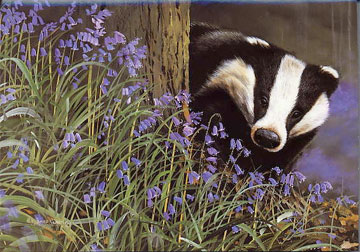 ‘Bluebell Time’ painting by Pollyanna Pickering |
Pollyanna Pickering:
I would like to see an immediate ban on keeping wild animals in circuses. It is impossible to offer them the space and care they need when traveling in small beast wagons, and it is demeaning to see them performing tricks for ‘entertainment’. There are of course also questions over the cruelty of many training methods used. Shows like Cirque du Soleil have shown that circuses do not need animals to be entertaining. In an ideal world we also wouldn’t have any animals in zoos – although I do respect the fact that many zoos do try very hard to provide a good environment for their animals through enrichment programmes, the quality of zoos varies immensely, and there are many which should be closed immediately. I also believe there are some animals which should never ever be kept in zoos as they are so unsuited to captivity – especially polar bears which are nomadic, and in their natural habitat roam thousands of miles during their lifetime. However I am aware that some zoos use the money they raise to support valuable conservation projects in the wild – Twycross zoo in England are currently working very hard to protect the habitat of the Bonobo in the Congo. As an artist I need to see animals in the wild – they look so different from the animals you see in cages.
Shubhobroto Ghosh: Could you name some of your wildlife heroes?
Pollyanna Pickering:
I have been lucky to meet some amazing and dedicated people working on behalf of wildlife – and some of the people who I admire the most are not well known – they are people working out in the field, or in wildlife sanctuaries to rescue and rehabilitate animals. I have supported the Born Free Foundation for many years, and admire Virginia McKenna greatly for her ceaseless dedication to ending the suffering of captive animals. I recently met Claudio Sillero, the Founder of the Ethiopian Wolf Conservation project, and I firmly believe without the work of him and his team these beautiful animals would already be extinct in the wild. Jane Goodall’s work was pioneering in its field – and David Attenborough has probably done more than anyone else to promote a general knowledge of and interest in wildlife.
Shubhobroto Ghosh: Did you ever meet Gerald Durrell?
Pollyanna Pickering:
No, unfortunately I never had the chance to meet him – although I did once see him driving his jeep on Jersey!
Shubhobroto Ghosh: What do you think of the policy of sustainable use of animals?
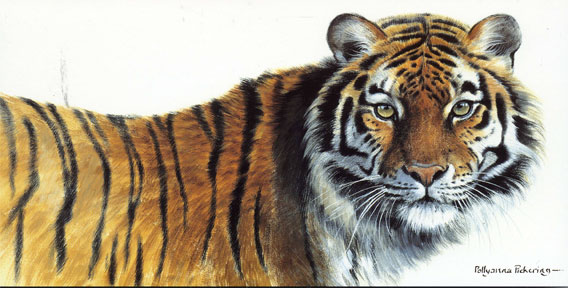 ‘Bluebell Time’ painting by Pollyanna Pickering |
Pollyanna Pickering:
If this question refers to the idea of culling wild populations as sustainable use I have deep reservations about it. There are many issues here, not least the methods used, and selection of animals – and in most cases I believe that nature has its own methods of population control – if an area cannot support an excessive number of animals, the population will naturally decline as the weakest will fail to survive, and we can often see natural fluctuations in wild populations. Another problem is the methods used for deciding culling quotas – how do you decide the optimal population density?
Shubhobroto Ghosh: Are you a vegetarian ? Do you approve of veganism as a lifestyle?
Pollyanna Pickering:
Yes I am vegetarian – although I have sometimes had to eat meat when I am traveling – especially in the high arctic, where of course it is impossible to eat crops, so we had to share the predominantly meat based diet of the Inuit! I have been vegetarian for about 30 years. I am not vegan, but I would certainly support anyone who chooses this lifestyle. I do however only buy free-range organic eggs, and select cheese and milk from ethically approved sources. In the past I have supported both Compassion in World Farming, and the RSPCA’s Freedom Food Campaign – both excellent projects aimed at improving the quality of life for farmed animals. I would like to see a complete ban on the production of battery eggs, and never buy them, or food products which may contain them.
Shubhobroto Ghosh: What is your view on fur, leather and silk and do you use these products? Do you think it is cruel to boil silkworms to obtain silk and if the material should be replaced by a more humane fabric? I ask because not many people recognize cruelty in silk.
Pollyanna Pickering:
I do have some leather shoes, where the leather is a by-product. I avoid silk, as I do think the production method is inhumane – and I would never wear fur! In fact I helped launch an anti-fur campaign with the RSPCA in Hong Kong some years ago – fur coats are sadly still a status symbol there.
Shubhobroto Ghosh: Can you narrate some of your interesting experiences in India?
Pollyanna Pickering: There have been so many that we’ve written a book about some of them! (The Eye of the Tiger, Otter House) India is such a fascinating country, and so varied in itself! My best moments have of course been wildlife related – my first ever sighting of a wild tiger, a very rare sighting of a leopard in Ranthambore, visiting the tigers rescued by Born Free at bhannerghatta – but there have been so many others – traveling on the trains, meeting remarkable people like Swami Nirmalanda, and my daughter being presented with a sloth bear cub on her 21st birthday to name a few!
Shubhobroto Ghosh: Are you in touch with any animal groups in India?
Pollyanna Pickering:
I am still in correspondence with the Wildlife Trust of India (thanks to your introduction!) and hope to find a way to work with them.
Shubhobroto Ghosh: Have you helped any animal welfare groups in India?
Pollyanna Pickering: I have raised funds for the sanctuary at Bhannerghatta, and also for Project Tiger through my exhibitions.
Shubhobroto Ghosh: What do you think of the work of WWF?
Pollyanna Pickering: The good thing about WWF is that as such a large and respected international organization, they are able to work in countries which other charities can’t – we have seen their work in China at a time when the government would not allow other charities in to many areas. We also visited their offices in Bhutan, where they are the only international wildlife charity in the entire country – and were very impressed by their work there, especially their Integrated Conservation and Development program.
Shubhobroto Ghosh: Which is your favourite animal?
Pollyanna Pickering: Impossible to choose!! I tend to be very involved with whichever animal I have just been studying – at the moment I am painting cheetahs.
Shubhobroto Ghosh: What are your views on animal experimentation?
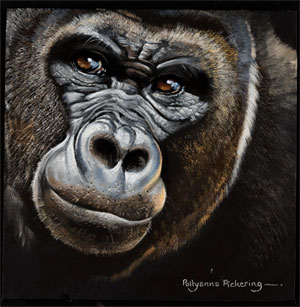 This painting will go on display to the public for the first time at Pollyanna’s Exhibition Born Free. Painting by Pollyanna Pickering |
Pollyanna Pickering: I am delighted that in March 2009, legislation came into effect, introducing a total ban on animal testing of cosmetics and cosmetic ingredients throughout Europe. There is no reason to use animals in cosmetic testing at all, and I welcome the ban. Medical experimentation is a slightly more difficult ethical issue, which would take a long time to discuss in detail! However I think it is absolutely vital that we encourage the use of non-animal alternatives in scientific procedures, and halt increases in the numbers of animals used. Sadly many Experiments are ethically abhorrent, and of course there are always question marks over the validity of testing on animals. I look forward to a day when alternatives are available and animal experimentation can be phased out completely.
Shubhobroto Ghosh: Is there an inherent conflict between animal rights and human rights?
Pollyanna Pickering: Absolutely not! I think almost the opposite – everything on the planet is interlinked, and it is vital we find a way to co-exist.. I am convinced that the refusal to believe that animals have intelligence and emotions has conveniently allowed us to exploit them both individually and as species – the more I work with animals the more I appreciate the complex social structures and emotional lives they have.
Shubhobroto Ghosh: Do people in England care more about animals than humans?
Pollyanna Pickering:
No! Although Britain is definitely a nation of animal lovers, I don’t think that it would be true to say we care about animals more than humans! I am sometimes asked if it is wrong to give money to animal charities when people are suffering as well and I find it a very strange question, because in my experience, most people who support animals also donate to good causes which help people – it is not an either or decision! If you are compassionate you generally want to help alleviate suffering whether animal or human and I find it odd that people find it possible to limit their compassion in this way! Although the Pollyanna Pickering Foundation primarily works to help animals and conservation, we also on occasion make grants to other causes close to my heart, including cancer support and children’s charities. At the moment we are collecting toys and clothes to send to an orphanage in Ethiopia. I also give a lot of talks every year, and many are fund-raising events for non-wildlife based charities such as The Children’s Society, and Air Ambulance.
Shubhobroto Ghosh: What do you think of groups that promote direct action to promote animal rights?
Pollyanna Pickering:
I understand their passion, but I think it is important to work strictly within the democratic system, and would condemn all illegal activity. I support any campaigns to help animals which stay within the law, and do not cause any harm to people!
Shubhobroto Ghosh: Do you see a distinct conflict between conservation and animal rights?
Pollyanna Pickering: No – again the two should work hand in hand. By conserving habitat we should be able to create areas of the world where animals can live in the wild with a minimum of human interference.
Shubhobroto Ghosh: What are the prospects of a wildlife painter?
Pollyanna Pickering: Hopefully very good! I am lucky that painting has no language barriers, which has meant that I can work all over the world. I am currently working on my sixth book, about wolves of the world, and am painting towards my winter exhibition which will be a celebration of Scottish wildlife.
Shubhobroto Ghosh: Please elaborate the goals of your foundation.
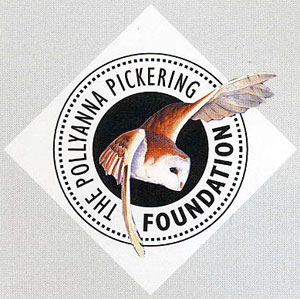 Pollyanna Pickering Foundation |
Pollyanna Pickering:
The Foundation was inaugurated just after I had taken the difficult decision to close my hospital for injured birds of prey, and wanted to find a way of carrying on my conservation and rescue work with wildlife. Initially the Foundation was set up to raise funds for wildlife hospitals and sanctuaries carrying out similar work in rehabilitating British wildlife, and continues to buy equipment and build pens for many centers in the UK. However the Foundation’s scope soon widened to raise funds for the protection and rescue of wildlife worldwide as well as emergency disaster relief. Funds have been raised to help protect Rhinos in Africa, Wolves in Ethiopia, orphaned polar bears in the arctic, and help build a tiger orphanage in Nepal. Equipment has been purchased for project tiger rangers working in India, and many smaller grants have been made to wildlife and environmental projects. We also campaign on environmental and animal welfare issues.
Shubhobroto Ghosh: How many countries have you visited?
Pollyanna Pickering: Just over thirty I think! However my cards, prints etc are sold in over 80 countries round the world, so I’ve got some way to go to catch up!
Shubhobroto Ghosh: How would Pollyanna Pickering like to be remembered?
Pollyanna Pickering: Through my painting.
Pollyanna Pickering Foundation
Shubhobroto Ghosh is a former journalist for the Telegraph newspaper whose work has also been published in the Times of India, The New York Times, Statesman, Asian Age, and the Hindu. Ghosh has been active in animal protection issues since the early nineties and is a member and supporter of several animal organizations, among them Durrell Wildlife Conservation Trust, Born Free Foundation, People For Animals and Beauty Without Cruelty. He has worked at the Wildlife Trust of India, was project coordinator for the Indian Zoo Inquiry project sponsored by Zoocheck Canada, and did his Masters thesis on British zoos.